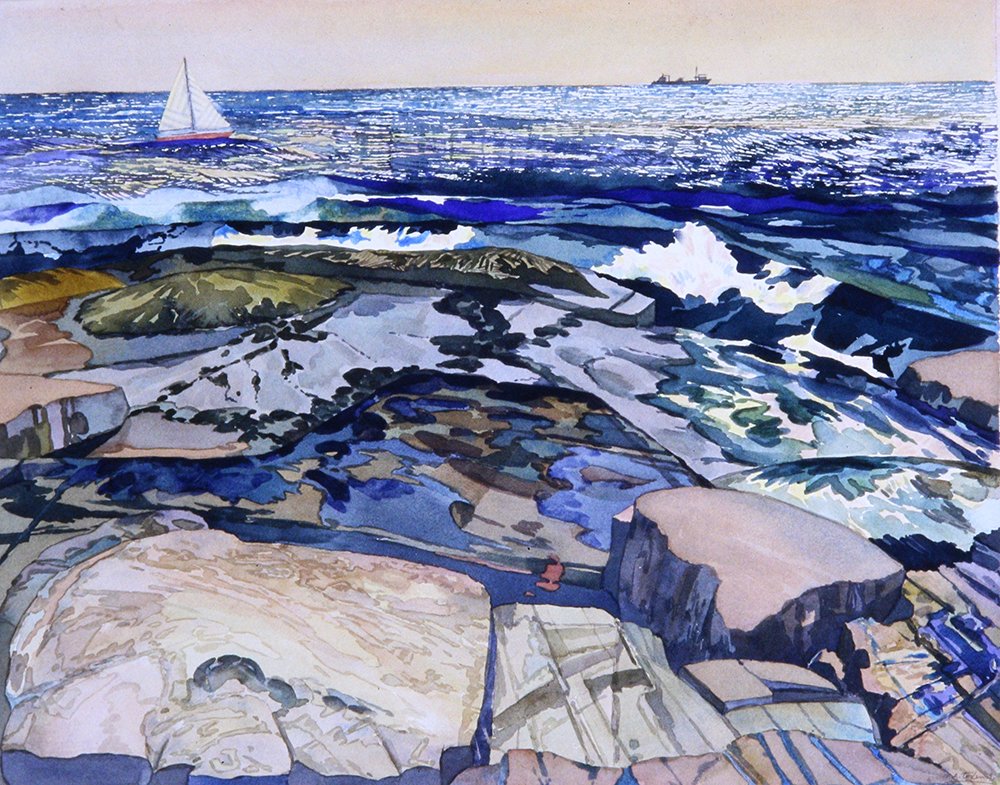On the Rocks
At 9 am, one warm summer day, my friend, Mark Howard, and I met at the dock to board a Lobsterman’s boat, on Little Cranberry Island, Maine. We headed for Baker Island to paint the Dancing Rocks. The lobsterman was on his way to fish. He dropped anchor near the shore and rowed us in his skiff to the water’s edge. We agreed to rendezvous back on the beach at 4pm.
Mark and I hauled our gear about ½ mile, across the island to the Dancing Rocks—huge slabs of pink, soft gray granite that tremble and gently rock as the thunderous tides of the Atlantic pound the shore.
Dancing Rock’s tides are variable and extreme, by turns exposing many layers of different vegetation clinging to rocks and floating in the sea. Blacks, umbers, ochres, sienna’s and aqua-marines, dance in the sunlight as the ultramarine waves sharply crack and roll into foaming, frothing whites. It is a dazzling visual experience, constantly changing.
Plein air painting the ocean is challenging. The motif is constantly changing—light, tides, surf, and sky, and nothing stays long enough to capture it. I always make it up as all plein air painter’s do. Photography never captures the experience, and that is why I like to paint the sea and rocks en plein air.
Mark and I set up our easels some distance from each other and worked. The only sound was the roar of surf. We stopped for lunch and then returned to our spots. We quit painting at 3 pm, packed up our gear, and headed back across the island to meet the boat.
The skiff was on the beach when we arrived. Anchored in enough water to keep the keel from going aground, the Lobster boat rolled and pitched, as the wind picked up, making boarding difficult. Once on board, we were soon underway.
I was excited to tell Mark what I felt like on the rocks, painting that day. I did not care about the painting; I was more interested in sharing what I had experienced. I told him that I felt I was in a groove, where everything worked. I felt in harmony with the crashing waves, the rocks, sea, and light. The process transformed me into another space, and it was glorious. I said, “It is better than making love.” Mark replied wryly, “you must be doing something wrong.” We laughed all the way back to the Little Cranberry Island.
Later, Mark wrote in an email, “It is amazing to me how perfectly awful my paintings appear in the early stages of the process. However, the process always seems to work.”
Artistic practice can be akin to other practices such as meditation and other contemplative disciplines, marathon running, or mountain climbing. As a practice, painting and drawing may be at once the cause and the result of an altered consciousness, a heightened awareness, which seems necessary for generating the creative flow, an awareness that calls for the integrated functioning of faculties—sensory, emotional, intellectual, intuitive, and physical. In the artist, it may produce a feeling that time and/or space no longer function in their usual way, or that some force is guiding the artist’s hand other than the artist’s own. It can seem as if the painting is “painting itself.” The process is carrying the artist along like a surfer in wave. The ego is set aside. An artist can feel as if they are a vehicle. The experience is of a higher order than self-expression. The outcome is a surprise.
No matter if the artist is painting from observation or is working in other modes, the “flow” experience is possible when process takes precedence over outcome.
Picasso said, “I do not seek, I find.”
Jackson Pollock said,
“When I am in my painting, I’m not aware of what I’m doing. It is only after a sort of ‘get acquainted’ period that I see what I have been about. I have no fears about making changes, destroying this image, etc., because the painting has a life of its own. I try to let it come through.”
NOTES:
--Inspired by my friendships and conversations with Mark Howard, and the late Charles Moone.
https://www.brainyquote.com/quotes/pablo_picasso_102142
https://medium.com/@ConwayHall/not-looking-at-pollock-5be86306296c

